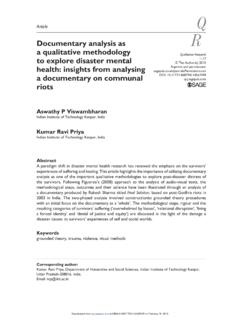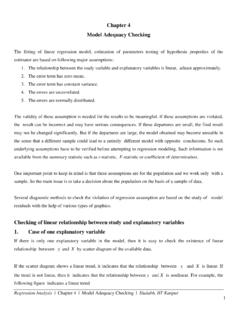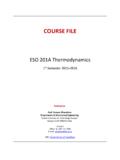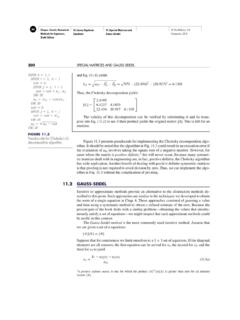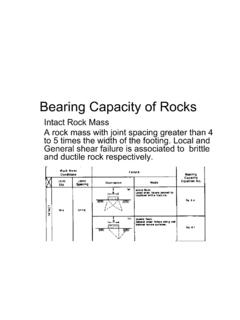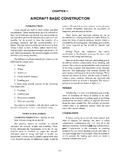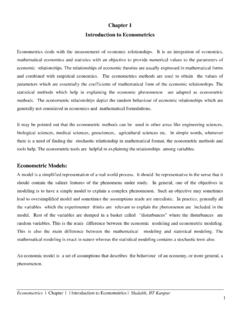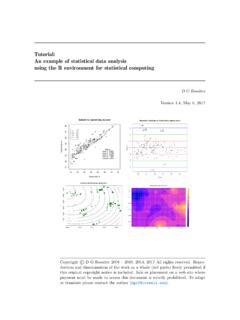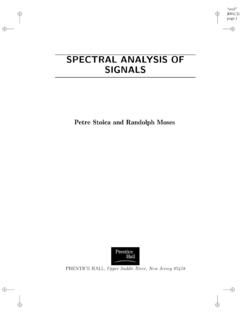Transcription of Chapter 4 Experimental Designs and Their Analysis
1 Chapter 4. Experimental Design and Their Analysis Design of experiment means how to design an experiment in the sense that how the observations or measurements should be obtained to answer a query in a valid, efficient and economical way. The designing of experiment and the Analysis of obtained data are inseparable. If the experiment is designed properly keeping in mind the question, then the data generated is valid and proper Analysis of data provides the valid statistical inferences. If the experiment is not well designed, the validity of the statistical inferences is questionable and may be invalid.
2 It is important to understand first the basic terminologies used in the Experimental design. Experimental unit: For conducting an experiment, the Experimental material is divided into smaller parts and each part is referred to as Experimental unit. The Experimental unit is randomly assigned to a treatment is the Experimental unit. The phrase randomly assigned is very important in this definition. Experiment: A way of getting an answer to a question which the experimenter wants to know. Treatment Different objects or procedures which are to be compared in an experiment are called treatments.
3 Sampling unit: The object that is measured in an experiment is called the sampling unit. This may be different from the Experimental unit. Factor: A factor is a variable defining a categorization. A factor can be fixed or random in nature. A factor is termed as fixed factor if all the levels of interest are included in the experiment. A factor is termed as random factor if all the levels of interest are not included in the experiment and those that are can be considered to be randomly chosen from all the levels of interest.
4 Replication: It is the repetition of the Experimental situation by replicating the Experimental unit. Analysis of variance | Chapter 4 | Extal. Design and Their Analysis | Shalabh, IIT Kanpur 1. Experimental error: The unexplained random part of variation in any experiment is termed as Experimental error. An estimate of Experimental error can be obtained by replication. Treatment design: A treatment design is the manner in which the levels of treatments are arranged in an experiment. Example: (Ref.: Statistical Design, G. Casella, Chapman and Hall, 2008).
5 Suppose some varieties of fish food is to be investigated on some species of fishes. The food is placed in the water tanks containing the fishes. The response is the increase in the weight of fish. The Experimental unit is the tank, as the treatment is applied to the tank, not to the fish. Note that if the experimenter had taken the fish in hand and placed the food in the mouth of fish, then the fish would have been the Experimental unit as long as each of the fish got an independent scoop of food. Design of experiment: One of the main objectives of designing an experiment is how to verify the hypothesis in an efficient and economical way.
6 In the contest of the null hypothesis of equality of several means of normal populations having same variances, the Analysis of variance technique can be used. Note that such techniques are based on certain statistical assumptions. If these assumptions are violated, the outcome of the test of hypothesis then may also be faulty and the Analysis of data may be meaningless. So the main question is how to obtain the data such that the assumptions are met and the data is readily available for the application of tools like Analysis of variance .
7 The designing of such mechanism to obtain such data is achieved by the design of experiment. After obtaining the sufficient Experimental unit, the treatments are allocated to the Experimental units in a random fashion. Design of experiment provides a method by which the treatments are placed at random on the Experimental units in such a way that the responses are estimated with the utmost precision possible. Principles of Experimental design: There are three basic principles of design which were developed by Sir Ronald A. Fisher.
8 (i) Randomization (ii) Replication (iii) Local control Analysis of variance | Chapter 4 | Extal. Design and Their Analysis | Shalabh, IIT Kanpur 2. (i) Randomization The principle of randomization involves the allocation of treatment to Experimental units at random to avoid any bias in the experiment resulting from the influence of some extraneous unknown factor that may affect the experiment. In the development of Analysis of variance , we assume that the errors are random and independent. In turn, the observations also become random.
9 The principle of randomization ensures this. The random assignment of Experimental units to treatments results in the following outcomes. a) It eliminates the systematic bias. b) It is needed to obtain a representative sample from the population. c) It helps in distributing the unknown variation due to confounded variables throughout the experiment and breaks the confounding influence. Randomization forms a basis of valid experiment but replication is also needed for the validity of the experiment. If the randomization process is such that every Experimental unit has an equal chance of receiving each treatment, it is called a complete randomization.
10 (ii) Replication: In the replication principle, any treatment is repeated a number of times to obtain a valid and more reliable estimate than which is possible with one observation only. Replication provides an efficient way of increasing the precision of an experiment. The precision increases with the increase in the number of observations. Replication provides more observations when the same treatment is used, so it increases precision. For example, if variance of x is 2 than variance of sample mean x based on n observation 2.
